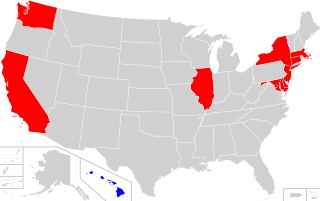In law, certiorari is a court process to seek judicial review of a decision of a lower court or government agency. Certiorari comes from the name of an English prerogative writ, issued by a superior court to direct that the record of the lower court be sent to the superior court for review. The term is Latin for "to be made more certain", and comes from the opening line of such writs, which traditionally began with the Latin words "Certiorari volumus...".

United States v. Stewart, 348 F.3d 1132 and 451 F.3d 1071, is a Ninth Circuit case involving a challenge to the constitutionality of 18 U.S.C. § 922(o) under the Commerce Clause of the United States Constitution. The United States Court of Appeals for the Ninth Circuit found against the defendant, ruling that possession of homemade machine guns can be constitutionally regulated by the United States Congress under the Commerce Clause.

The Supreme Court of the United States is the highest court in the federal judiciary of the United States. The procedures of the Court are governed by the U.S. Constitution, various federal statutes, and its own internal rules. Since 1869, the Court has consisted of one chief justice and eight associate justices. Justices are nominated by the president, and with the advice and consent (confirmation) of the U.S. Senate, appointed to the Court by the president. Once appointed, justices have lifetime tenure unless they resign, retire, or are removed from office.

Bump stocks or bump fire stocks are gun stocks that can be used to assist in bump firing, the act of using the recoil of a semi-automatic firearm to fire cartridges in rapid succession.

The Supreme Court of the United States handed down sixteen per curiam opinions during its 2005 term, which lasted from October 3, 2005, until October 1, 2006.

The Supreme Court of the United States handed down eight per curiam opinions during its 2006 term, which began October 2, 2006 and concluded September 30, 2007.

Short-barreled rifle broadly refers to any rifle with an unusually short barrel. The term carbine describes a production rifle with a reduced barrel length for easier handling in confined spaces. Concern about concealment for illegal purposes has encouraged regulations specifying minimum barrel lengths and overall lengths.
McDonald v. City of Chicago, 561 U.S. 742 (2010), was a landmark decision of the Supreme Court of the United States that found that the right of an individual to "keep and bear arms", as protected under the Second Amendment, is incorporated by the Fourteenth Amendment and is thereby enforceable against the states. The decision cleared up the uncertainty left in the wake of District of Columbia v. Heller (2008) as to the scope of gun rights in regard to the states.

The Supreme Court of the United States handed down nineteen per curiam opinions during its 2009 term, which began on October 5, 2009, and concluded October 3, 2010.

The Supreme Court of the United States handed down nine per curiam opinions during its 2001 term, which began October 1, 2001, and concluded October 6, 2002.

The Supreme Court of the United States handed down fourteen per curiam opinions during its 2011 term, which began October 3, 2011 and concluded September 30, 2012.

Peruta v. San Diego, 824 F.3d 919, was a decision of the United States Court of Appeals for the Ninth Circuit pertaining to the legality of San Diego County's restrictive policy regarding requiring documentation of "good cause" that "distinguish[es] the applicant from the mainstream and places the applicant in harm's way" before issuing a concealed carry permit.

Assault weapons legislation in the United States refers to bills and laws that define and restrict or make illegal the manufacture, transfer, and possession of assault weapons. How these firearms are defined and regulated varies from jurisdiction to jurisdiction; generally, this constitutes a list of specific firearms and combinations of features on semiautomatic firearms.

The Supreme Court of the United States handed down eighteen per curiam opinions during its 2015 term, which began October 5, 2015 and concluded October 2, 2016.
V.L. v. E.L., 577 U.S. 404 (2016), is a case decided by the Supreme Court of the United States concerning the adoption rights of same-sex couples. In 2007, a Georgia Superior Court granted adoption rights to V.L., the partner of E.L., the woman who gave birth to their three children. However, after moving back to Alabama, the couple split up. E.L. tried to block V.L. from seeing the children, but V.L. filed a lawsuit seeking visitation and other parental rights. On September 18, 2015, the Supreme Court of Alabama ruled that the state did not have to recognize the adoption judgment, saying that the Georgia court misapplied its own state law. The court voided the recognition of the adoption judgment in Alabama. V.L. petitioned the United States Supreme Court to stay the ruling during her appeal and allow her to see her children. On December 14, 2015, the Supreme Court stayed the ruling pending their action on a petition for a writ of certiorari filed by V.L. On March 7, 2016, the Supreme Court of the United States reversed the decision of the Alabama Supreme Court by per curiam summary disposition.

The 2016 Proposition 63, titled Firearms and Ammunition Sales, is a California ballot proposition that passed on the November 8, 2016 ballot. It requires a background check and California Department of Justice authorization to purchase ammunition, prohibits possession of high-capacity ammunition magazines over ten rounds, levies fines for failing to report when guns are stolen or lost, establishes procedures for enforcing laws prohibiting firearm possession by specified persons, and requires California Department of Justice's participation in the federal National Instant Criminal Background Check System.
New York State Rifle & Pistol Association, Inc. v. City of New York, New York, 590 U.S. ___ (2020), abbreviated NYSRPA v. NYC and also known as NYSRPA I to distinguish it from the subsequent case, was a case addressing whether the gun ownership laws of New York City, which restrict the transport of a licensed firearm out of one's home, violated the Second Amendment to the United States Constitution, the U.S. Constitution's Commerce Clause, and the right to travel. It was the first major gun-related case that the Supreme Court had accepted for review in nearly ten years, after District of Columbia v. Heller (2008) and McDonald v. City of Chicago (2010). After the Supreme Court agreed to hear the case, New York City and New York state amended its laws to allay the challenged provision. In a per curiam decision in April 2020, the Supreme Court determined that the case was moot, vacating and remanding the case to lower courts to determine "whether petitioners may still add a claim for damages in this lawsuit with respect to New York City's old rule".
Rehaif v. United States, 588 U.S. ___ (2019), was a case before the United States Supreme Court dealing with mens rea. The Court held that when a person is charged with possessing a gun while prohibited from doing so under 18 U.S.C. § 922(g), the prosecution must prove both that the accused knew that they possessed a gun and that they knew they held the relevant status.
Jones v. Hendrix, 599 U.S. 465 (2023), was a United States Supreme Court case related to habeas corpus.
A binary trigger is a device that allows a semi-automatic firearm to fire at an increased rate. The binary trigger works by firing one shot upon pulling the trigger and then firing a subsequent shot upon release of the trigger.






